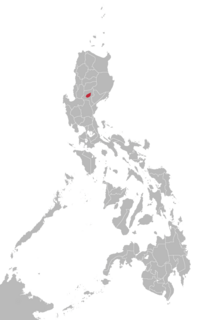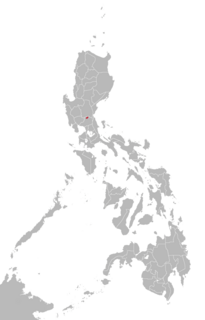Related Research Articles

The Philippine languages are a proposed group by R. David Paul Zorc (1986) and Robert Blust that include all the languages of the Philippines and northern Sulawesi—except Sama–Bajaw and a few languages of Palawan—and form a subfamily of Austronesian languages. Although the Philippines is near the center of Austronesian expansion from Formosa, there is little linguistic diversity among the approximately 150 Philippine languages, suggesting that earlier diversity has been erased by the spread of the ancestor of the modern Philippine languages.

Altaelva is the third-longest river in Troms og Finnmark county, Norway. The river begins in the mountains and lakes in Kautokeino Municipality, near the border with Troms og Finnmark county and Finland, just south of Reisa National Park. The 240-kilometre (150 mi) long river then runs northward into Alta Municipality where it flows out into the Altafjorden in the town of Alta. The river has carved out Sautso, one of the largest canyons in Europe on its way from the high Finnmarksvidda plateau down to the sea. The villages of Kautokeino and Masi are located along the river, in addition to the town of Alta.

The Northern Cordilleran Volcanic Province (NCVP), formerly known as the Stikine Volcanic Belt, is a geologic province defined by the occurrence of Miocene to Holocene volcanoes in the Pacific Northwest of North America. This belt of volcanoes extends roughly north-northwest from northwestern British Columbia and the Alaska Panhandle through Yukon to the Southeast Fairbanks Census Area of far eastern Alaska, in a corridor hundreds of kilometres wide. It is the most recently defined volcanic province in the Western Cordillera. It has formed due to extensional cracking of the North American continent—similar to other on-land extensional volcanic zones, including the Basin and Range Province and the East African Rift. Although taking its name from the Western Cordillera, this term is a geologic grouping rather than a geographic one. The southmost part of the NCVP has more, and larger, volcanoes than does the rest of the NCVP; further north it is less clearly delineated, describing a large arch that sways westward through central Yukon.
The Old Cordilleran Culture, also known as the Cascade phase, is an ancient culture of Native Americans that settled in the Pacific Northwestern region of North America that existed from 9000 or 10000 BC until about 5500 BC.

The Iskut-Unuk River Cones are a group of eight small basaltic centres at the southern end of the Northern Cordilleran Volcanic Province in the Boundary Ranges of the Coast Mountains, in western North America. The lava flows date back 70,000 years, but the subaerial vents produced cinder cones and lava flows that were probably all active between about 9,000 and a few hundred years ago. The last lava flows were erupted from The Volcano about 150 years ago. Iskut Canyon Cone produced at least 10 thick lava flows which initially dammed the Iskut River.

Volcano Mountain is a cinder cone in central Yukon Territory, Canada, located a short distance north of Fort Selkirk, near the confluence of the Pelly and Yukon Rivers. Volcano Mountain is called Nelrúna in the Northern Tutchone language.

Castle Rock is a volcanic plug located 13 km (8 mi) west of Iskut and 8 km (5 mi) northwest of Tuktsayda Mountain in British Columbia, Canada. Castle Rock is part of the Pacific Ring of Fire that includes over 160 active volcanoes and is in the Klastline Group, Northern Cordilleran Volcanic Province and last erupted in the Pleistocene.
Prindle Volcano is an isolated basaltic cinder cone located in eastern Alaska, United States, in the headwaters of the East Fork of the Fortymile River. The cone is fresh-looking and has a base approximately 900 metres wide. It is the northwesternmost expression of the Northern Cordilleran Volcanic Province. The cinder cone, and an approximately 11-kilometre (6.8-mile) long lava flow which breached the margin of the cone, erupted in the Pleistocene approximately 176,000 years ago. Rocks forming the Prindle Volcano occur within, and penetrated through, the Yukon–Tanana upland which is a large region of mostly Paleozoic-Mesozoic metamorphosed and deformed sedimentary, volcanic, and intrusive rocks that are intruded by younger Cretaceous and Cenozoic granitic rocks. Xenoliths in the volcano's ejecta provide a sample of lower crust material.

Cartoona Peak, also unofficially called Cartoona Ridge, is a volcanic peak in northern British Columbia, Canada, located just southeast of Coffee Crater in Mount Edziza Provincial Park.
The Meso-Cordilleran languages are a group of languages spoken in or near the Cordillera Central mountain range in Northern Luzon. Its speakers are culturally very diverse, and include the lowland Pangasinense, the Igorot highlanders, and Alta-speaking Aeta groups.
Chikoida Mountain is a mountain on the Taku Plateau in northwestern British Columbia, Canada, located 52 km (32 mi) southeast of Atlin on the east side of the Silver Salmon River.
Arta is a highly endangered Negrito language of the northern Philippines.
The Negrito peoples of the Philippines speak various Philippine languages. They have more in common with neighboring languages than with each other, and are listed here merely as an aid to identification.

Isinai is a Northern Luzon language primarily spoken in Nueva Vizcaya province in the northern Philippines. By linguistic classification, it is more divergent from other Central Cordilleran languages, such as Kalinga, Itneg or Ifugao and Kankanaey.

Southern Alta, is a distinctive Aeta language of the mountains of northern Philippines. This article will discuss Southern Alta's location, vocabulary, similarities and differences shared with other languages of the Philippines. Southern Alta is one of many endangered languages that risks being lost if it is not passed on by current speakers. Most speakers of Southern Alta also speak Filipino.

Northern Alta is a distinctive Aeta language of the mountains of northern Philippines. It is not close to Southern Alta or to other languages of Luzon.

The Northern Luzon languages are one of the few established large groups within Philippine languages. These are mostly located in and around the Cordillera Central of northern Luzon in the Philippines. Among its major languages are Ilokano, Pangasinan and Ibanag.
The Southern Cordilleran languages are a group of closely related languages within the Northern Luzon subgroup of the Austronesian language family. They are spoken in an area stretching from the southern shore of the Lingayen Gulf to the highlands of Quirino province. The most widely spoken Southern Cordilleran language is Pangasinan, one of the eight major languages of the Philippines.
The Central Cordilleran languages are a group of closely related languages within the Northern Luzon subgroup of the Austronesian language family. They are spoken in the interior highlands of Northern Luzon in the Cordillera Central mountain range.
References
- Austronesian Basic Vocabulary Database, 2008.
- Reid, Lawrence A. (2013) "Who Are the Philippine Negritos? Evidence from Language." Human Biology: Vol. 85: Iss. 1, Article 15.